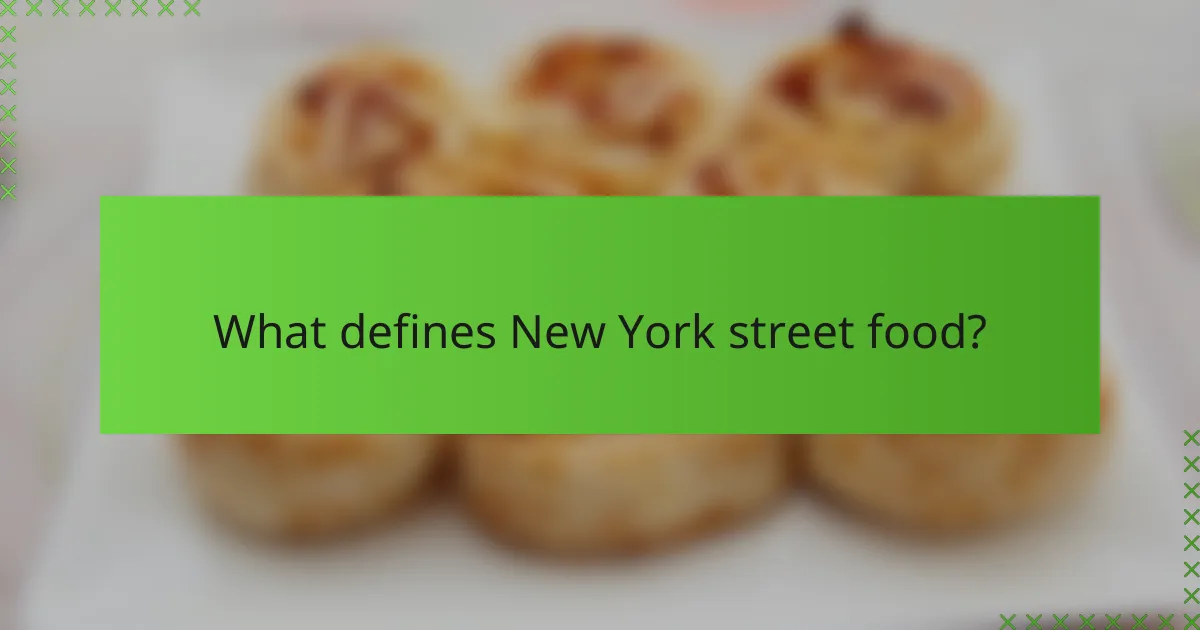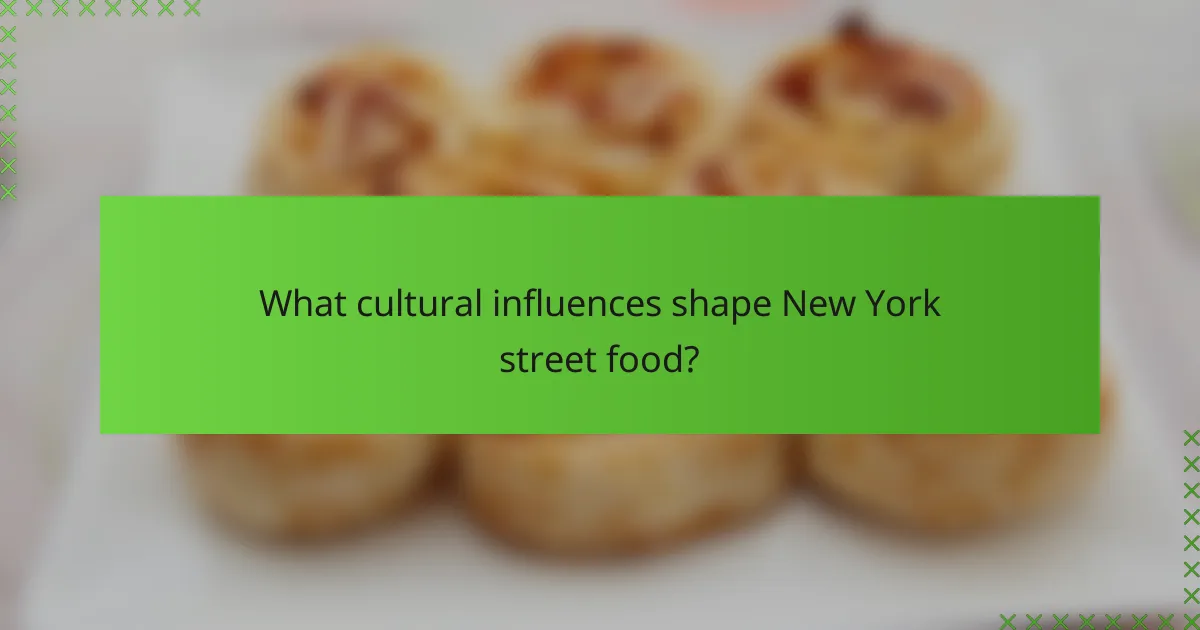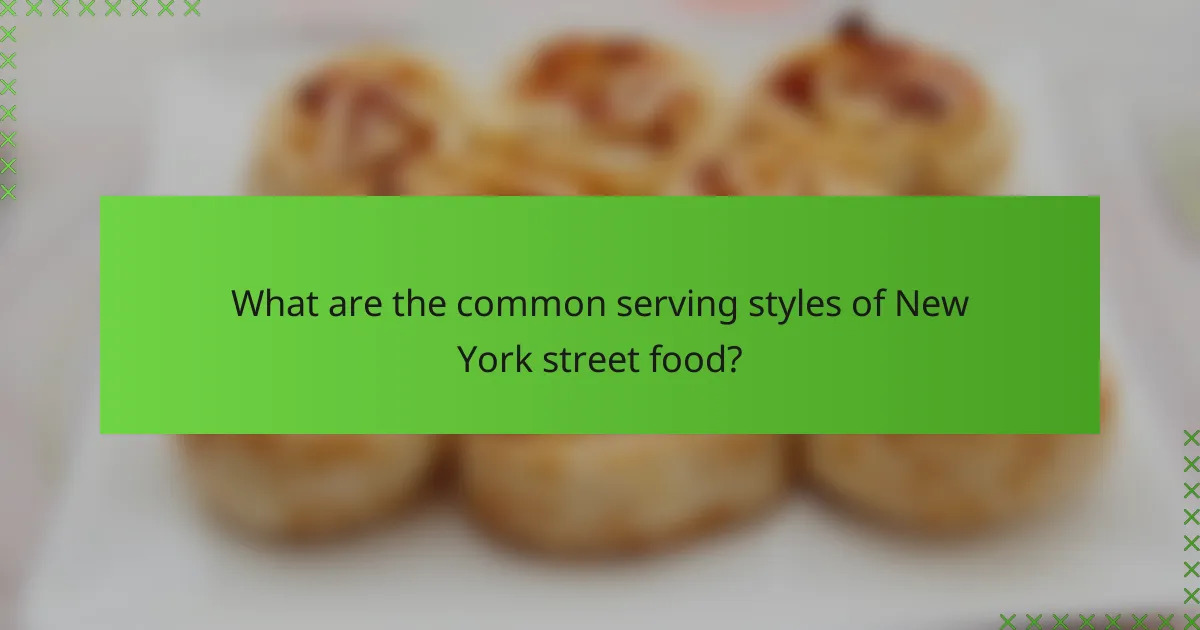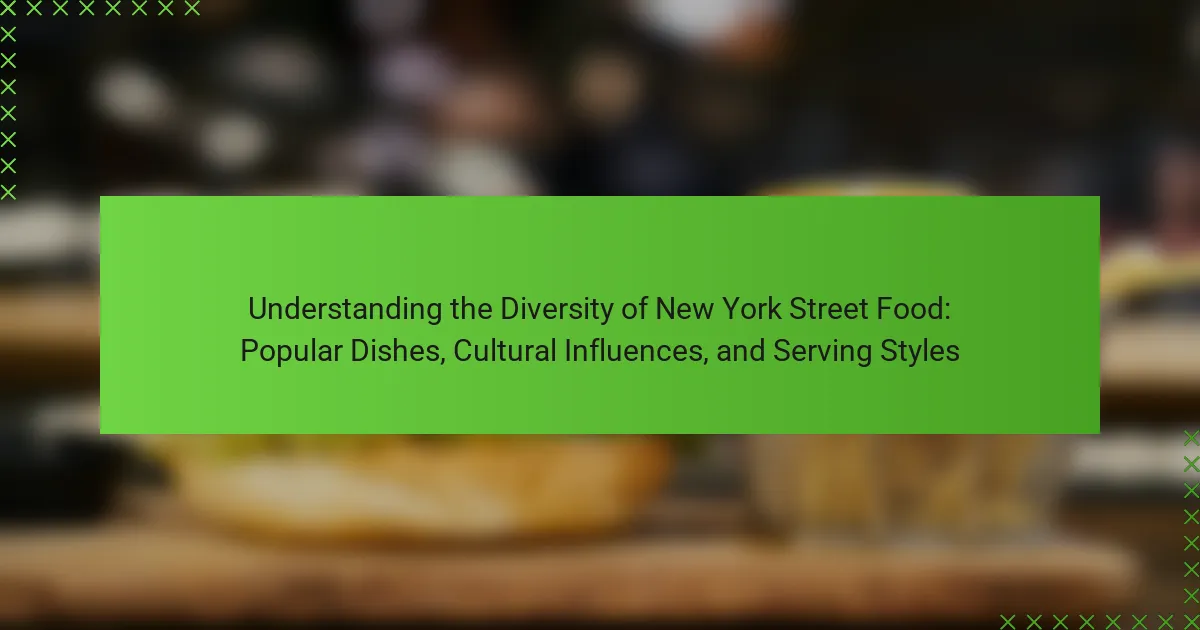
What defines New York street food?
New York street food is defined by its diverse offerings and cultural influences. It includes a variety of cuisines, reflecting the city’s melting pot of cultures. Popular items include hot dogs, pretzels, and halal food. Food trucks and carts serve these dishes throughout the city. The street food scene is characterized by quick, accessible meals. Many vendors operate in busy areas, catering to locals and tourists alike. The food is often affordable, making it a staple for many. This diversity showcases the culinary heritage of New York City.
How did New York street food evolve over time?
New York street food evolved significantly from the 19th century to the present. Initially, it consisted of simple items like pretzels and roasted chestnuts sold by vendors. The influx of immigrants introduced diverse cuisines, such as Italian, Chinese, and Mexican foods. By the mid-20th century, food trucks began to appear, offering a wider variety of options. The 2000s saw a surge in gourmet food trucks, which elevated street food to a culinary experience. Today, New York street food reflects global influences, with fusion dishes becoming popular. This evolution showcases the city’s cultural diversity and adaptability over time.
What historical events influenced the development of street food in New York?
The development of street food in New York was influenced by several historical events. The arrival of immigrants in the late 19th and early 20th centuries brought diverse culinary traditions. Notable waves included Italian, Jewish, and Chinese immigrants, each contributing unique dishes. The 1890s saw the rise of pushcarts selling food in urban areas. Economic factors, such as the Great Depression, increased reliance on affordable street food options. The post-World War II era led to a boom in food trucks and mobile vendors. The 1970s and 1980s saw a resurgence of interest in ethnic street food. Today, street food continues to evolve, reflecting New York’s multicultural landscape.
How do immigrant communities contribute to the diversity of street food?
Immigrant communities significantly enhance the diversity of street food. They introduce unique culinary traditions and flavors from their home countries. Each community brings specific ingredients and cooking techniques. For example, Mexican immigrants popularized tacos and elote in New York. Similarly, Chinese immigrants introduced dumplings and bao. These foods reflect their cultural heritage and adapt to local tastes. Research indicates that street food reflects the multicultural fabric of urban areas. A study by the New York City Department of Health highlights the variety of cuisines available in street food markets. This diversity fosters cultural exchange and community engagement.
What are the most popular street food dishes in New York?
The most popular street food dishes in New York include hot dogs, pretzels, and halal carts. Hot dogs are iconic and found at numerous street vendors. They are typically served with mustard and sauerkraut. Pretzels are another favorite, often sold by street vendors in various sizes. Halal carts offer dishes like chicken and rice, seasoned with spices and served with salad and sauce. Tacos and dumplings have also gained popularity among street food enthusiasts. These dishes reflect the city’s diverse culinary influences. The variety caters to different tastes and preferences, making New York’s street food scene vibrant and dynamic.
Which dishes are considered iconic in New York street food culture?
New York street food culture is defined by several iconic dishes. Hot dogs are among the most recognizable, often sold from street carts. They originated in the early 20th century and remain a staple. Another iconic dish is the New York-style pizza, known for its thin crust and large slices. This pizza style became popular in the 1900s and is widely celebrated. Pretzels, sold by street vendors, are also iconic and have a long history in the city. Additionally, halal food, particularly chicken and rice, has gained immense popularity since the early 2000s. These dishes reflect the diverse cultural influences in New York. Each dish contributes to the vibrant street food scene.
How do flavors and ingredients vary among popular dishes?
Flavors and ingredients among popular dishes vary significantly due to cultural influences and regional availability. For example, New York street food reflects a blend of global cuisines. Dishes like tacos incorporate spicy elements, while falafel features herbs and spices like cumin and coriander. Hot dogs are typically seasoned with mustard and ketchup, showcasing American tastes. Additionally, ingredients like bread, rice, and vegetables differ based on the dish’s origin. The fusion of these elements creates unique flavor profiles. This diversity is evident in the variety of offerings available in New York’s street food scene.
What are the health considerations associated with popular street food dishes?
Health considerations associated with popular street food dishes include hygiene, nutritional value, and ingredient quality. Street food often varies in preparation methods, which can affect safety. High-fat and high-sugar content in some dishes can lead to health issues like obesity and heart disease. Contaminated water or improper food handling can cause foodborne illnesses. Fresh ingredients are crucial for reducing health risks. Regulatory standards vary, impacting food safety. Awareness of allergens is essential for consumer safety. Consuming street food in moderation can mitigate negative health effects.

What cultural influences shape New York street food?
New York street food is shaped by diverse cultural influences. The city’s immigrant history plays a significant role in this diversity. Various ethnic communities have introduced their culinary traditions. For example, Italian immigrants popularized pizza and pasta dishes. Latin American cultures brought tacos, empanadas, and arepas. Asian communities contributed dumplings, bao, and pho. Middle Eastern influences are evident in dishes like falafel and kebabs. Each cultural group has adapted their food to local tastes. This fusion creates a unique street food scene that reflects New York’s multicultural identity. The variety of flavors and styles attracts locals and tourists alike.
How do different cultures contribute to the street food scene?
Different cultures significantly contribute to the street food scene by introducing diverse flavors and cooking techniques. For example, Asian cultures bring dishes like dumplings and bao buns. Latin American cultures add tacos and empanadas, showcasing their unique spices and ingredients. Middle Eastern cultures offer falafel and shawarma, which highlight their traditional methods of preparation. Each cultural influence enriches the street food landscape, making it more vibrant and varied. The presence of food trucks and stalls reflects this cultural diversity, attracting a wide range of customers. Statistics show that multicultural neighborhoods often have thriving street food markets, enhancing community engagement.
Which cuisines are most represented in New York street food?
The most represented cuisines in New York street food include Mexican, Chinese, and Middle Eastern. Mexican street food features tacos and quesadillas, popular among locals and tourists. Chinese vendors offer dumplings and bao, attracting a diverse crowd. Middle Eastern options like falafel and shawarma are also widely available. These cuisines reflect the city’s multicultural population. Data from the NYC Department of Health indicates a significant presence of food trucks and carts serving these dishes. This variety showcases the culinary diversity found in New York’s street food scene.
How do cultural festivals influence street food offerings?
Cultural festivals significantly influence street food offerings by showcasing diverse culinary traditions. These events attract large crowds, encouraging vendors to adapt their menus to reflect the festival’s cultural themes. For example, during the Lunar New Year celebrations, vendors often feature traditional Asian dishes like dumplings and rice cakes. Festivals also promote regional specialties, allowing local ingredients to shine. Research indicates that food diversity at these events enhances community engagement and cultural exchange. According to a study by the Food and Agriculture Organization, festivals contribute to the preservation of culinary heritage. This dynamic interaction between culture and cuisine enriches the street food landscape in urban areas like New York.
What role does street food play in New York’s cultural identity?
Street food is a vital component of New York’s cultural identity. It reflects the city’s diversity through a wide variety of cuisines. Vendors offer dishes from around the world, showcasing immigrant cultures. This accessibility fosters community interaction and cultural exchange. Street food is often affordable, making it a staple for many New Yorkers. Events like the New York Street Food Festival highlight its significance. The unique flavors and culinary traditions contribute to the city’s vibrant atmosphere. Overall, street food embodies the spirit of New York as a melting pot of cultures.
How does street food reflect the city’s diversity?
Street food reflects the city’s diversity by showcasing a variety of cultural cuisines. Each dish represents the heritage of different communities within the city. For example, food trucks often serve tacos, representing Mexican culture. Halal carts highlight Middle Eastern influences with their seasoned meats and rice. Vendors selling dumplings reflect the Chinese immigrant population. The availability of these diverse options illustrates the multicultural fabric of the city. According to the New York City Department of Health, there are over 4,000 food vendors offering various ethnic foods. This variety not only caters to local tastes but also attracts tourists seeking authentic culinary experiences.
In what ways does street food foster community engagement?
Street food fosters community engagement by creating shared dining experiences. It brings people together in public spaces, encouraging social interactions. Vendors often interact with customers, fostering a sense of connection. Street food markets host diverse cuisines, showcasing cultural diversity. This variety attracts different community members, enhancing inclusivity. Events centered around street food promote local culture and traditions. Research shows that communal dining can strengthen neighborhood ties. According to a study by the University of California, street food markets increase community cohesion and local pride.

What are the common serving styles of New York street food?
Common serving styles of New York street food include takeout containers, paper plates, and food trucks. Takeout containers are often used for items like fried rice or noodles. Paper plates serve dishes such as hot dogs and sandwiches. Food trucks provide a mobile option for a variety of cuisines. Many vendors also utilize wax paper or foil for wrapping items. These styles cater to convenience and portability. The serving methods reflect the fast-paced lifestyle of New Yorkers. Street food culture emphasizes quick service and easy consumption.
How do serving styles vary among different street food vendors?
Serving styles among different street food vendors vary significantly based on cultural influences and food types. For example, vendors selling tacos often serve them on small plates with various toppings on the side. In contrast, falafel vendors typically serve their food in pita bread or as a wrap, making it easy to eat on the go. Hot dog vendors usually present their products in buns, often accompanied by condiments in squeeze bottles.
Asian street food vendors might serve dishes like dumplings in bamboo steamers or bowls, emphasizing presentation. Additionally, some vendors use carts with built-in grills, allowing for fresh cooking in front of customers. Others may have food trucks that offer a more extensive menu with plated meals. The choice of serving style reflects the vendor’s culinary tradition and practicality for customers.
Research indicates that these variations enhance the overall street food experience, catering to diverse consumer preferences and cultural expectations.
What are the most popular methods of serving street food?
The most popular methods of serving street food include food trucks, carts, and stands. Food trucks offer a mobile kitchen experience with a diverse menu. Carts are often stationary and serve quick items like hot dogs or pretzels. Stands provide a simple setup for vendors to sell items directly to customers. Each method allows for easy access and quick service. Street food is typically served in disposable containers to facilitate on-the-go eating. The convenience of these methods contributes to the popularity of street food culture.
How do presentation and packaging impact the street food experience?
Presentation and packaging significantly enhance the street food experience. Visually appealing presentation attracts customers and stimulates appetite. Packaging serves practical purposes, such as maintaining food temperature and preventing spills. Effective packaging can also communicate cultural identity and brand values. Research shows that consumers often associate quality with attractive presentation. A study published in the Journal of Food Science found that well-packaged food increases perceived value. In a bustling environment like New York, convenience in packaging is crucial for on-the-go consumption. Overall, these elements contribute to customer satisfaction and can influence purchasing decisions.
What trends are emerging in New York street food serving styles?
Emerging trends in New York street food serving styles include the use of eco-friendly packaging and gourmet presentations. Many vendors are adopting biodegradable materials to reduce waste. This shift aligns with growing environmental awareness among consumers. Additionally, food trucks are increasingly offering upscale dishes, elevating the street food experience. Unique flavor combinations and fusion cuisines are also becoming popular. Vendors are experimenting with global influences, reflecting the city’s diverse culture. Trendy presentation styles, such as artisanal plating, are gaining traction. These changes cater to a more health-conscious and adventurous clientele. Overall, innovation in serving styles is reshaping New York’s street food landscape.
How are sustainability practices influencing serving methods?
Sustainability practices are significantly influencing serving methods in street food. Vendors are increasingly adopting eco-friendly materials for packaging. Biodegradable containers and utensils are replacing plastic options. This shift reduces waste and environmental impact. Many food trucks now use local ingredients to minimize carbon footprints. Seasonal menus are becoming common, promoting sustainability. Some vendors offer discounts for customers who bring reusable containers. These practices reflect a growing awareness of environmental issues. Research shows that consumers prefer businesses that prioritize sustainability.
What innovations are being introduced in street food serving styles?
Innovations in street food serving styles include the use of eco-friendly packaging. Many vendors now utilize biodegradable or compostable materials. This shift addresses environmental concerns associated with single-use plastics. Additionally, digital ordering systems are gaining popularity. These systems streamline the ordering process and reduce wait times for customers. Food trucks are also incorporating modular setups for flexibility. This allows vendors to adapt their serving styles based on location and demand. Furthermore, some vendors are embracing interactive serving experiences. For instance, customers can customize their meals in real-time. These innovations enhance convenience and sustainability in street food service.
What tips can enhance the New York street food experience?
To enhance the New York street food experience, try a variety of vendors. Each vendor offers unique flavors and specialties. Explore different neighborhoods to discover diverse cuisines. Timing is important; visit during peak hours for the freshest food. Engage with the vendors; they often share interesting stories about their dishes. Don’t hesitate to try something new; street food is about adventure. Pay attention to cleanliness; choose vendors with high turnover for better food safety. Lastly, consider sharing dishes with friends to sample more options. These tips can significantly enrich your culinary journey in New York.
New York street food is a diverse culinary landscape shaped by various cultural influences, featuring popular dishes such as hot dogs, pretzels, and halal food. The evolution of this food scene reflects the city’s immigrant history, with contributions from Italian, Chinese, and Mexican communities, among others. The article explores the historical events that influenced street food development, the significance of immigrant contributions, and the most iconic dishes that define New York’s street food culture. Additionally, it examines serving styles, emerging trends, and sustainability practices that enhance the street food experience in the city.
